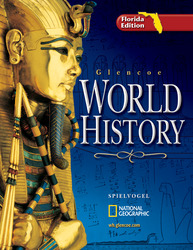Glencoe World History, Florida EditionChapter 9:
Emerging Europe and the Byzantine Empire, 400–1300Chapter OverviewsA new European civilization emerged in which monarchs competed for supremacy with the nobility and the Roman Catholic Church. Europeans embarked on the Crusades in an effort to regain the Holy Land from the Muslims. The Byzantine Empire became the seat of the Eastern Orthodox Church and developed its own unique civilization. Section 1 Transforming the Roman World
Of the German states that replaced the Western Roman Empire, only the Frankish kingdom proved long lasting. Its founder, Clovis, was the first Germanic leader to convert to Christianity. The kingdom was eventually divided among his heirs. Meanwhile, the blending of German and Roman cultures was forming a new society in which the Church played a growing role. Pope Gregory I took control of Rome and its surrounding territories and used the monastic movement to attract Christian converts. Pepin reunited the Frankish Kingdom, setting the stage for his son, Charles, or Charlemagne, to form the vast Carolingian Empire. Charlemagne's need for educated clergy and government officials helped sparked a revival of learning and culture sometimes called the Carolingian Renaissance. Section 2 Feudalism
After Charlemagne's death, Magyar, Muslim, and Viking invaders caused the break-up of the empire. As central governments collapsed, people sought local sources of safety and security. This led to a new political and social system called feudalism. Feudalism was based on a hierarchy of relationships between lords and the vassals who took an oath to fight for them. In exchange, vassals received parcels of land, called fiefs. Knights, lance-bearing horsemen dressed in coats of mail, dominated warfare and became the backbone of the aristocracy. Knights were supposed to uphold a code of ethics known as chivalry, although this was not always the case. Women remained subordinate to men in many respects, but a growing number oversaw large households and complex finances while men were away at war. Section 3 The Growth of European Kingdoms
During the High Middle Ages, European monarchs began to extend their power and build strong states. In England and France, pressure from the nobility and other social groups led to the granting of parliamentary representation. The Frankish Kingdom was weakened by its effort to control both Italy and Germany. Both states remained decentralized and without a national monarchy. The Slavic peoples of central Europe had become divided into three major groups. The western Slavs adopted the Roman Catholic Church, while most of the southern and eastern Slavs adopted Eastern Orthodox Christianity. Slavs who settled in present-day Ukraine and Russia were dominated first by Viking rulers and later by Mongols. Section 4 The Byzantine Empire and the Crusades
After briefly regaining control of the Mediterranean, the Eastern Roman Empire was reduced to the Balkans and Asia Minor. This smaller empire, known as the Byzantine Empire, was home to Europe's greatest center of commerce, Constantinople, and to the Eastern Orthodox Church, the empire's spiritual center. Meanwhile, a permanent schism developed with the Catholic Church in Rome. The Seljuk Turk invasion prompted the emperor to turn to Europe for help. The result was a series of European-led Crusades to liberate the Holy Land. Amid horrible violence, crusading armies conquered Jerusalem and established crusader states. After the Muslims retook Jerusalem in 1187, several more Crusades proved unsuccessful. One result of the Crusades was Christian violence against Jews, which became a feature of medieval European life.  | 

















